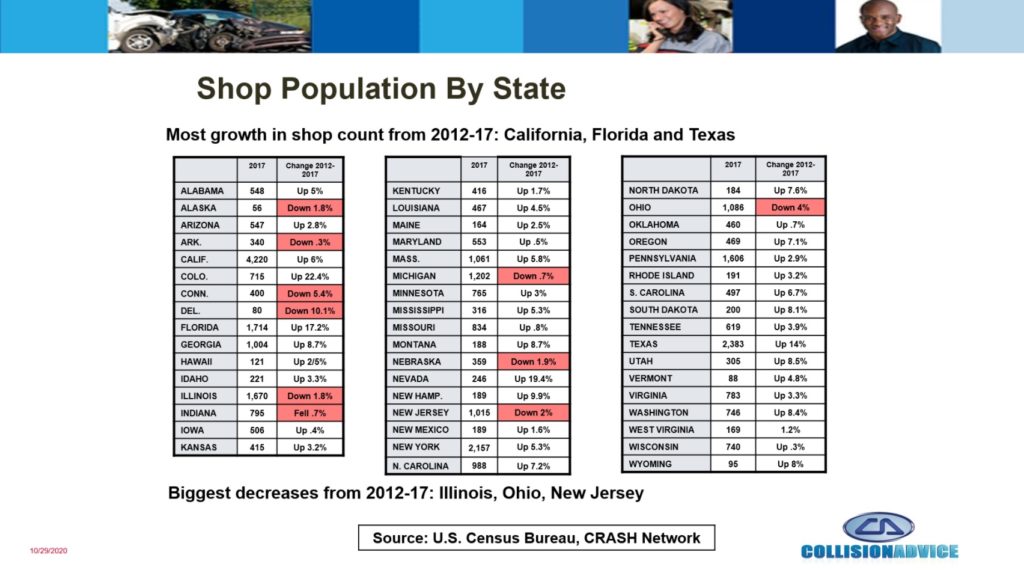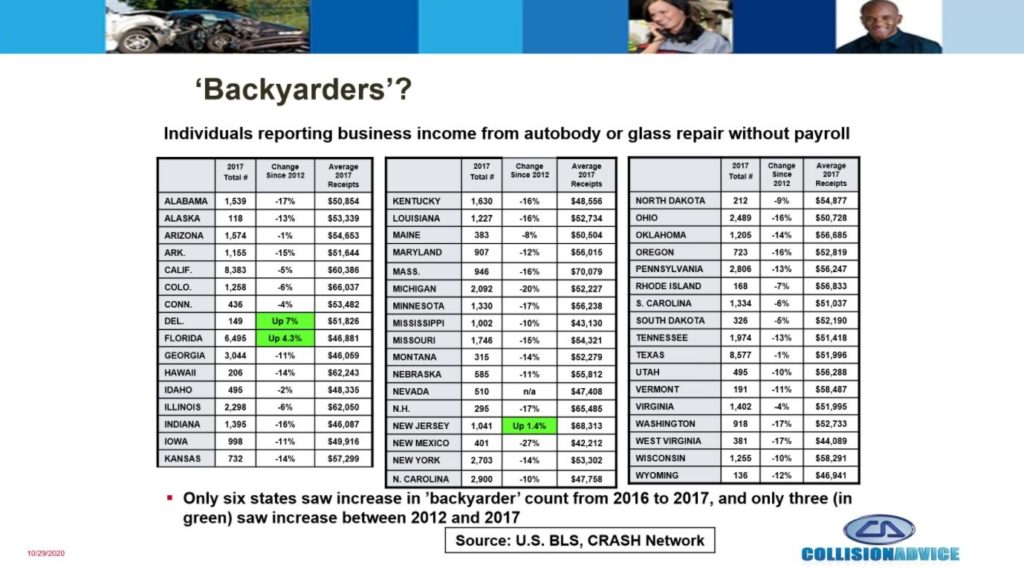
CRASH Network, Collision Advice: ‘Backyarder’ auto body shops are the ones disappearing
By onBusiness Practices | Market Trends
Despite reports of shops closing their doors, industry experts for years have fixed the number of collision repair businesses at between 32,000-36,000, Collision Advice CEO Mike Anderson said on a webinar this fall.
“The number never changed,” he said during an Oct. 29 event.
Untangling these two contradictory trends — vanishing shops yet a steady business count — requires going deeper and considering what Anderson called “backyarder” body shops, according to the webinar.
Anderson presented 2017 Census Bureau data — the most recent available — collected by CRASH Network.
The chart showed the number of auto body repair businesses in each state that year who paid payroll taxes. It contrasted these tallies with 2012 shop counts.
Only 10 states saw declines, with the largest reductions in Illinois, Ohio and New Jersey. The industry seems to be holding steady.
But CRASH Network also collected data on auto body businesses who didn’t incur payroll taxes. (Anderson suggested such businesses might be paying employees in cash, be family-operated companies, or using 1099 independent contractor setups.) The results here are fascinating.
No state had a “backyarder” population averaging six figures in business income, based on the publications’ analysis of Bureau of Labor Statistics information.
These are “really small shops,” Anderson said.
The “backyarder” population dwarfs the number of collision repairers who owe payroll taxes. However, the “backyarder” population also plummeted by double-digit percentages in most states between 2012 and 2017.
Anderson used the example of Georgia. In 2017, the state saw 1,004 body shops who paid payroll taxes, up 8.7 percent from 2012.
But another 3,044 Georgia entities posted business income from auto body or glass repair without experiencing payroll taxes. Those Georgia “backyarder” companies averaged $46,881 in receipts.
“That’s the number of shops that’s actually declining,” Anderson said. That’s who’s “declining and going out of business,” Anderson said.
That business population fell by 11 percent — more than 300 shops — from 2012 to 2017.
All but six states saw year-over-year declines in “backyarder” auto body and glass operations between 2016 and 2017, according to CRASH Network’s analysis of Bureau of Labor Statistics data. Only Delaware, Florida and New Jersey had more shops in 2017 than they did in 2012.
It’s also interesting to see how the number of major collision companies has to some degree held steady — but the number of locations controlled by those companies has grown.
We pulled Census data for businesses within the federal NAICS industry Category 811121, “Automotive Body, Paint, and Interior Repair and Maintenance,” between 2012-17. This appears to be capturing the same payroll tax-paying companies CRASH Network did.
Based on our analysis, the number of “Automotive Body, Paint, and Interior Repair and Maintenance” firms in the U.S. stood at 32,427 in 2012 and rose to 32,696 in 2017. However, this 269-firm increase in overall companies was accompanied by a net growth of 1,624 locations and 33,152 employees.
And of course, the federal data only reaches 2017. The industry has seen some significant consolidation since then. So it’ll be interesting to see what future Census data reports for 2018-20.
Images:
NAICS 811121 “Automotive Body, Paint, and Interior Repair and Maintenance” firms in the U.S. stood at 32,427 in 2012 and rose to 32,696 in 2017, according to Census Bureau data. (seamartini/iStock)
CRASH Network compiled these statistics on auto body repair companies which pay payroll taxes. (Provided by CRASH Network and Collision Advice)
CRASH Network compiled these statistics on auto body repair companies which don’t meet the criteria to pay payroll taxes. (Provided by CRASH Network and Collision Advice)


